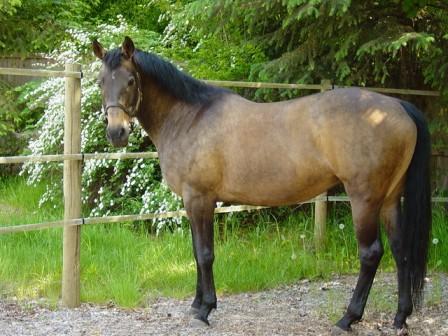Site Menu:
| This is an archived Horseadvice.com Discussion. The parent article and menus are available on the navigation menu below: |
| HorseAdvice.com » Training, Behavior, & Conditioning Horses » Conformation » |
| Discussion on Long back | |
| Author | Message |
| Member: maggienm |
Posted on Thursday, Feb 26, 2009 - 4:17 pm: There has been a lot of talk about the length of a horses back.A long back horse is weaker. Weaker is a general term. And how long? According to J. WarDrOpe a line from hip to hip should be about one finger width in front of the LS joint. More distance is long. So if there is two fingers is the horse only good for low level riding and maybe a few bounces, three fingers and only pleasure riding, four fingers..... thanks for your thoughts. |
| Member: stek |
Posted on Thursday, Feb 26, 2009 - 6:15 pm: Interesting question Lori. I can't offer any specific guidelines, but wanted to comment that one breed I have worked with that seem to be chronically long-backed (standardbreds) are used for harness racing and not generally for riding. Though I know they are also used successfully as riding horses.I have a mare who I think is a bit long-bodied, though if her neck were longer I think she would seem more proportional to me. (pic below) She also seems to me to be longer-bellied than -backed if that makes sense, which I have heard is worse than just long backed. This improves when she is kept in work and fit. I think there is some difference though between a horse with a long back and one with a long croup, where the peak of the croup (the LS joint) falls close to the point of the hip as opposed to farther back? The latter I believe is desirable in jumpers? 
|
| Member: ajudson1 |
Posted on Thursday, Feb 26, 2009 - 9:29 pm: When my husband and I first started riding together, we both rode Arabs. His was about 14.3, mine barely 14.2...but there was a lot of difference in length of their backs. I think Fancy was 4" longer than Willow...sure seemed that way. Fancy is no longer with us; but her back never seemed weak or swayed. Willow on the other hand looks sway backed very easily especially when she gets a hay belly in the winter.There was differences in their pastern angles and lengths also which affected their gaits. Fancy walked extremely fast, had a rough trot and canter. Willow had, still has, a slower walk, and more springy trot, o.k. canter. I've always thought a short back is better, but I think it depends on many other factors and you have to consider the whole package. Interesting question. |
| Member: canter |
Posted on Friday, Feb 27, 2009 - 7:38 am: I think it also depends on what you want to do with the horse and how the back ties in to the hind end. A horse with a long, low back, for example, that ties in to a weak hind end, will have difficulty in collected work.But, as Angie says above, the "whole package" and how it's put together can compensate for some less than perfect confirmation. I remember when I started riding dressage, my then instructor pulled out one of the horses in the barn and asked me to evaluate his confirmation. He was a large QH, and to look at him, he had just about every confirmational fault you could think of (although none were extreme) that would make him a terrible mover and less than ideal as a dressage mount. Yet, under saddle, he was a lovely mover and one well known clinician said that he had great potential to move up the levels. Many of his faults "balanced" out some of the other faults, if that makes any sense. However, good confirmation increases the chances that a horse stays sound under the stress of work/training so that must always be considered. |
| Member: imogen |
Posted on Friday, Feb 27, 2009 - 8:38 am: Driving horses often had longer backs in the past. To hold a collar, the horse must have a solid, cob-type upright shoulder which produces an uncomfortable ride, a fast trot and difficulty beginning to canter due to the large shoulder blade being obstructed by the rider's weight.All these qualities are bonuses if you are driving rather than riding. Many Irish cobs are a bit long-backed and this reflects their origin as draught animals (providing power for agriculture and transport). All the best Imogen |
Horseadvice.com
is The Horseman's Advisor
Helping Thousands of Equestrians, Farriers, and Veterinarians Every Day
All rights reserved, © 1997 -
is The Horseman's Advisor
Helping Thousands of Equestrians, Farriers, and Veterinarians Every Day
All rights reserved, © 1997 -
